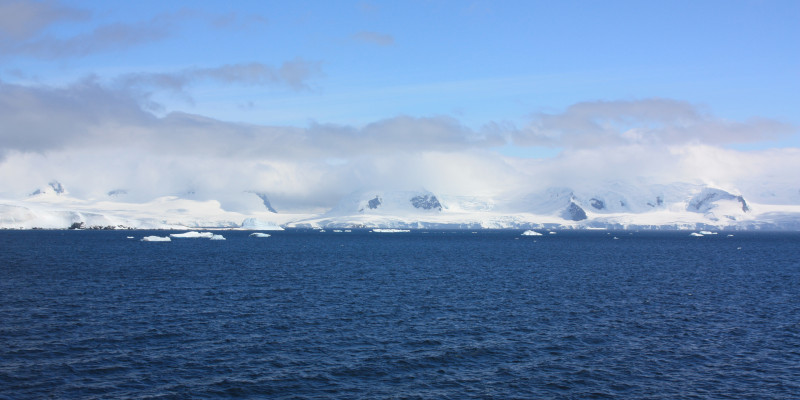The very low temperatures in the Antarctic are largely due to a low level of radiant energy input. In the austral summer – wintertime in the northern hemisphere – the South Pole is inclined towards the sun and there are 24 hours of daylight. Because of the ecliptic plane, that is the tilt of the earth's axis of 23.5° in relation to its orbit around the sun, the sun's rays are very weak even in summertime. Furthermore, the snow has very high reflective power (albedo), and therefore most of the sun's energy cannot be absorbed and heat radiation is greater than solar irradiation (negative radiation balance of the Antarctic). The Antarctic does not warm appreciably even with non-stop solar radiation during the austral summer. Because of the tilt of the Earth's axis away from the sun during the Antarctic winter (Northern summer), it is dark 24 hours a day and no solar radiation can warm the continent.
Great regional differences within the Antarctic
Whereas there is a somewhat oceanic climate in the coastal areas of West Antarctica, the climate is more continental in central East Antarctica. As a rule, temperatures decrease with distance inland because the effects of the ocean do not cool down the coasts considerably. The average winter temperatures of -20 to -30°C along the coasts are well above the average inland winter temperatures of -60° to -70°C, making Antarctica the coldest continent on Earth. The lowest temperature recorded on site was measured at the Russian research station Vostok in eastern Antarctica in 1983: -89.6°C. Summer temperatures along the coasts rise to an average -25 to 0°C and an average -40°C inland.
Only a few regions of the Antarctic Peninsula regularly reach temperatures above the freezing point, yet the western part of this Peninsula in particular is greatly affected by global climate change. No other region on Earth is warming at a rate as fast as here. Temperature data from the Oak Ridge National Laboratory collected from research stations on the Antarctic Peninsula indicate there has been an increase of the annual average temperature of up to 2°C in the last 50 years. There is data to support a warming of the continent of about 0.12°C per decade.
Extremely high wind speeds and little precipitation
There are strong winds in the Antarctic, caused by high-altitude inflowing air masses which form a high pressure area with a stable fair weather area above the central plateau. As the air masses cool down, they sink downwards and flow towards the coasts (fall winds). These katabatic winds play a major role in the formation of coastal polynyas, sea ice formation and thereby the generation of Antarctic bottom water. The phenomenon is especially pronounced off the large shelf ice areas in the Ross Sea and Weddell Sea. Very high wind speeds are common in eastern regions in particular. The storm region between King George Land and Victoria Land experiences 340 stormy days a year with wind speeds of over 300 km/h.
Precipitation in the Antarctic occurs mainly in the form of snowfall in the winter months. In the high pressure area at the centre of Antarctica, precipitation occurs only as a result of the cooling of high-altitude air masses. Precipitation of less than 50 mm per year in central Antarctica is a very low level and makes it something of an arid ice desert. Precipitation increases closer to the coastal regions, reaching about 600 mm per year. The islands off the coast experience average annual precipitation rates of up to 1,000 mm.
And by the way..:
What is the difference between Antarctic sea ice and Arctic sea ice?
Arctic sea ice is perennial and covers virtually the entire Arctic Ocean in winter. The seasonal changes in the ice cover are not as extreme and it is warmer than in the Antarctic. The glaciation of the Antarctic began about 15 million years ago. It is colder than in the Arctic, and the extent of the ice cover depends heavily on seasonal changes. Whereas only some four million square kilometres are covered in ice during the austral summer, the ice cover in the winter increases to about 20 million square kilometres. The sea ice in the Southern Ocean on the other hand is mostly annual.
 Click to enlarge
Click to enlarge





